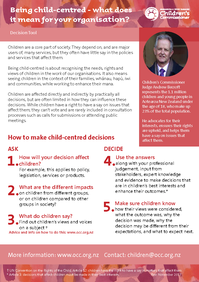1 November 2017 Reports
Being child-centred - Decision tool
Children are a core part of society. They depend on and are major users of, many services, but they often have little say in the policies and services that affect them.
Being child-centred is about recognising the needs, rights and views of children in the work of our organisations. It also means seeing children in the context of their families, whānau, hapū, iwi and communities, while working to enhance their mana.
Children are affected directly and indirectly by practically all decisions but are often limited in how they can influence these decisions. While children have a right to have a say on issues that affect them, they can’t vote and are rarely included in consultation processes such as calls for submissions or attending public meetings.
How to make child-centred decisions
ASK
- How will your decision affect children?
For example, this applies to policy, legislation, services or products.
- What are the different impacts on children from different groups, or on children compared to other groups in society?
- What do children say? Find out children’s views and voices on a subject.
UN Convention on the Rights of the Child, Article 12: Children have the right to have a say in matters that affect them.
DECIDE
- Use the answers along with your professional judgement, input from stakeholders, expert knowledge and evidence to make decisions that are in children’s best interests and enhance their outcomes.
UN Convention on the Rights of the Child, Article 3: decisions that affect children must be made in their best interests.
- Make sure children know how their views were considered, what the outcome was, why the decision was made, why the decision may be different from their expectations, and what to expect next.
